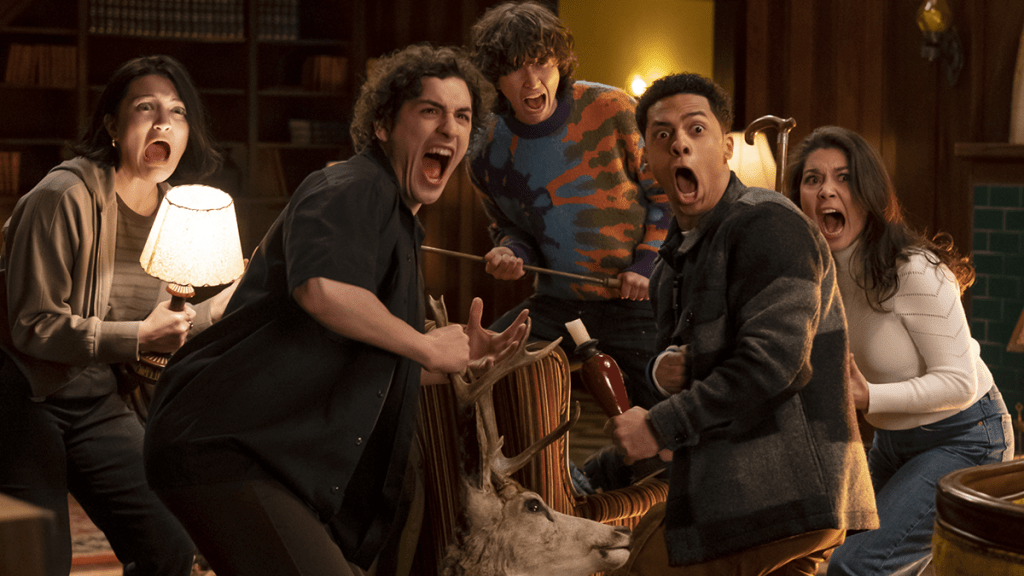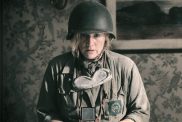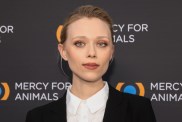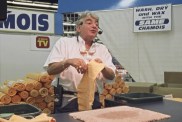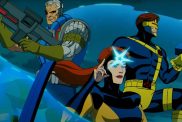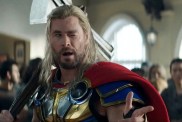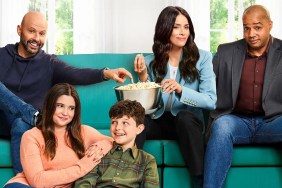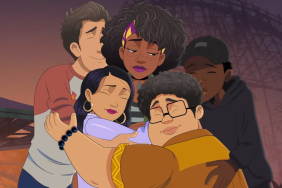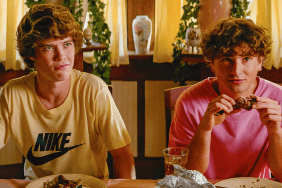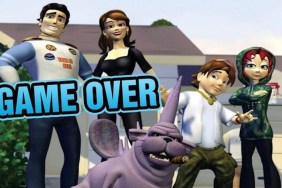ComingSoon Senior Editor Spencer Legacy spoke with Goosebumps executive producers Pavun Shetty and Conor Welch about the Hulu horror series. The duo discussed making a more serialized series and their favorite entries in the classic ’90s book series.
“Plunging viewers into a world of mystery and suspense, the new Goosebumps series follows a group of five high schoolers as they embark on a shadowy and twisted journey to investigate the tragic passing three decades earlier of a teen named Harold Biddle — while also unearthing dark secrets from their parents’ past,” reads the new series’ logline.
Spencer Legacy: The new Goosebumps series adapts some classic Goosebumps stories, but it also features a continuous and serialized story at the same time. What was behind that choice and what were some of the challenges that came with that approach?
Pavun Shetty: Yeah, so the book series, which we grew up on, and the original 90s Canadian TV series were purely anthological. Scholastic, who publishes the books, gave us access to all of them. So it was a real challenge, figuring out which one of these iconic stories we’re going to take and adapt. I think we never wanted to do purely an anthology show. We wanted to have an ongoing narrative and a serialized element throughout the entire series. So the original structure, which we ended up doing, was to take five of the most iconic stories and the most popular stories and use those for the first five episodes.
Each of our teens in the show finds out that they’re being haunted by a totem that they found in this haunted house and those stories come from five different books in the Goosebumps canon. Then for the back half of the season, when our teams come together to save the town, we didn’t really pull from any particular books for a whole episode. We just pulled elements from a bunch of different books. So it was never going to be an anthology, from the beginning, but we knew we wanted to take a lot of the books and highlight them in the front half and then just put Easter eggs in from everything else.
Justin Long is so great at both comedy and horror with things like Barbarian last year. How did he get involved with the project, and what was it like to have him in it?
Conor Welch: He was actually one of the first actors that we cast and for exactly that reason. He plays so well in both the horror and the comedy genre. He had just come off of Barbarian when we put him in this show. It was important to us that everyone that we cast — Rachael Harris and Rob Huebel being examples — knew how to land a joke. They knew the timing of comedy but also were able to lend depth and nuance to some of the more emotional beats because it was important that the dramatic moments felt really real and really grounded. But yeah, Justin perfectly personified the type of actor we wanted in our show, who is both surprising and very adept at both genres. So we were very, very lucky to have him.
Goosebumps is thought of as a good entry point for horror for younger people, but this version gets a little darker and it’s aged up a bit. What led to the decision to age it up with this new take?
Pavun Shetty: I think we wanted this version to appeal to both kids and adults equally and authentically. We intentionally developed a show where kids could watch the show alone and feel like they were watching something that was a little bit too scary for them, which is what the books did. That kids could watch with their parents and that parents and adults without kids could watch as well. So in order to do that, you need to take some of the scares and make them a little bit more intense. I think you need to take a lot of the comedy and make it a little bit more sophisticated.
We wanted everything to feel real. The issues that kids are dealing with are real high school issues. The issues that the parents are dealing with are real issues that adults face. I think a lot of the horror … we wanted to make sure that it was linked to what the kids were actually going through, which made it feel more real, too. But we never wanted to go too bloody or too gory. It wasn’t supposed to be so intense that people would turn it off and be disgusted by it. But in order to be really scary, I think you need to crank it up just a little bit.
Similarly, a lot of these stories were written in the ’90s and have some very ’90s stuff in them. How difficult was it to modernize the general stories for this new take?
Conor Welch: We found, actually, that a lot of the issues that we faced in high school in the ’90s, meaning Pavun and I and the other creators, are actually quite similar to the issues that that kids are still facing these days in terms of unrequited first love and ideas of identity and popularity and how to fit in. So a lot of those issues are quite evergreen. It was interesting to create a show that felt as contemporary as possible, with kids talking like kids talk these days and going through things that kids go through these days.
In fact, our five young adult actors, who were cast as our five young leads, were very helpful in making sure that it all felt authentic to their lived experience. So, too, were some of the younger members of our writer staff. It was really important that it felt very contemporary, but also that the parents’ story felt relatable as well, and that when we flash back to the ’90s to see some similarities between the issues that the parents dealt with then and the issues that their kids are dealing with now.
Speaking of the younger cast members, they’re all really so excellent in this. What was the process of assembling this really ideal group like?
Pavun Shetty: They’re great. We auditioned hundreds and hundreds of people for the roles. One of our touchstones for the show is Freaks and Geeks, as far as the comedy goes — like really awkward, real teen comedy. I think, in order to get that, we needed to make sure that the people that we cast felt real and felt like real high school kids and that they were dealing with the same kinds of things. We were lucky enough to find this group and they were able to rehearse a lot and be together before we even started shooting. The dynamic felt real.
Obviously in the show, it’s a bunch of kids who wouldn’t be friends — they wouldn’t sit together at a lunch table, like, by design. They sort of come together and realize that they have a lot more in common than they thought. But we wanted to make sure Justin and the other adult cast that this group had comedy, that they were able to do drama pretty well too and seamlessly. I think that they felt like real, authentic kids that liked each other and had fun with each other.
There’s an interesting twist on the “revenge on the bullies’ kids” story in that the adults aren’t entirely unaware of what’s happening in Goosebumps. They kind of know something’s happening. Was it difficult to incorporate adults into the story?
Conor Welch: I think it was pretty natural insofar as we wanted to subvert expectation of the genre in every way that we could. A lot of the Goosebumps books and, frankly, a lot of young adult horror tends to revolve around the idea that the parents are not believing in the kids and the kids having to band together and prove to the parents that they’re not going crazy or lying to them. In our situation, there is some of that going on, but there’s also an element of the parents being withholding to the children. So we thought that it would be funny or compelling to flip it in that way so that the parents both maybe weren’t trusting what the kids were telling them, but the kids learned that they maybe couldn’t trust everything that the parents were sharing with them, as well. So it led to a really interesting dynamic and subverted expectations, a little bit, of the genre.
These stories are very well-known to a generation, so how did you adapt them while also keeping them a little new and fresh and surprising for people who already are aware of them?
Pavun Shetty: Well, the intention was definitely to honor the original stories, which are so iconic, so people who read the books would love them, but also not be alienating the people who didn’t read the original books or watch the original series. Like we discussed before, I think the issues the kids face being real and contemporary and also timeless at the same time was really important to that. Everyone likes being scared. There’s a reason horror movies do so well, and there’s a reason comedies are great — just like horror — to see in groups and in theaters, and they’re just such genres that you have visceral reactions to. I think horror is sort of timeless. The issues that kids are dealing with are timeless and the stories in the books, even though they were written in the ’90s, we took them as inspiration and built upon them so that they didn’t feel like they’d be alienating if you didn’t read them.
How’d you pick which stories to include? R.L. Stine‘s written so many stories throughout Goosebumps? How’d you pick which ones that you really wanted to include?
Conor Welch: We needed books where the issues at the center were as relatable as possible. Each of our first five, I think, are some of the more popular from the canon because they’re super relatable in the issue that they’re kind of exploiting with the horror genre. They also had to have elements or totems, as we call them, that could be found at a haunted house — so a Polaroid camera, a mask, a cuckoo clock: all tangible things that these first five main characters could stumble across as they crossed paths at the haunted house in the pilot episode. So those were the elements that led us towards choosing them. Then, as Pavun said, after our group comes together about halfway through the season, we pepper in different Easter eggs from other books along the way as well, which should be a treat to fans of the series.
Which Goosebumps story is each of your personal favorites?
Pavun Shetty: I was always a Haunted Mask fan, which we do in our second episode. It’s a great idea — the mask giving someone confidence and finally being seen when they actually can’t see their face is a very symbolic and interesting thing. But also on a horror level, the idea of putting something on your face that you can’t take off always stuck with me, literally. [Laughs]. So I think that that’s the one for me.
Conor Welch: And Go Eat Worms. I had a visceral reaction to growing up and haven’t looked at worms nor spaghetti the same way since. [Laughs]. There’s something very creepy about worms and getting them in your system and having them control you. So it was really exciting to be able to take that idea and run with it for, I think, our fifth episode of the season where we get a huge, horrifying worm monster, which I think the audience will really enjoy.
